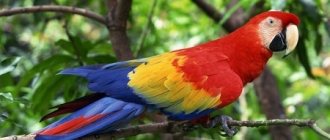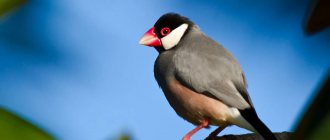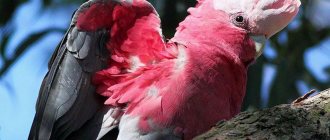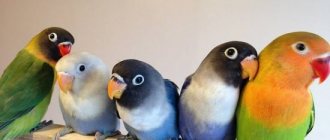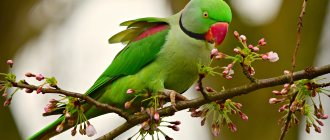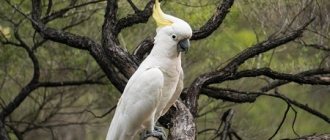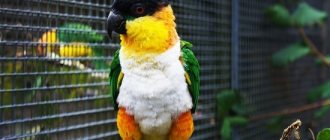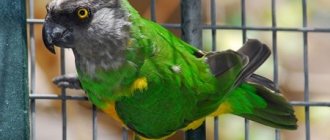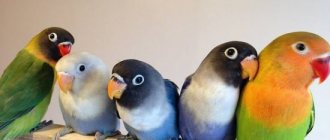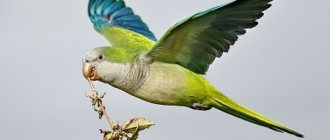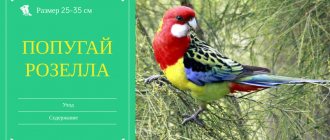Many people dream of having a pet, but cannot devote enough time to it: communicating, walking, keeping it clean. In this case, the Gouldian finch, a fragile bird from the wax-billed weaver family, may be a suitable option. She does not need walks, does not require special conditions of detention, calmly tolerates “imprisonment” in a cage, but she cannot do without feathered company. If two colorful birds appear in the house at once, the whole family will soon fall in love with them.
Appearance of Gould's finch
Ornamental birds, finches, are very small - the size of an adult is only 13-15 cm from the tip of the beak to the tip of the tail. The strong cone-shaped beak seems to be sculpted from wax - its surface is smooth and shiny. Long, fragile legs are pink or gray. The eyes are small and black.
Gould's finches are intricately colored: head, chest, abdomen, back - each part of the body has its own color with clear boundaries. Between the head and the back there is a dividing line in the form of an azure or black stripe. The plumage contains blue, purple, green, yellow, black and others. The abdomen is most often yellow. The coverts are green. The multi-colored bird has such a neat, smooth appearance, as if painted with gouache.
Based on the color of the head, three types of Gould's finches are distinguished:
- blackheads (most common);
- redheads;
- orange-headed (rare).
Various color mutations of finches have been obtained through selection. Hybrid forms have light “bibs”: pink, white or beige, while in natural finches this area is blue.
On a note! It is believed that a bird's temperament is determined by the color of its head. Most black-headed finches behave calmly, but red-headed finches are noticeably more aggressive and curious.
What a wonderful creature
Finches belong to the family of weaver finches (songbirds from the order Passeriformes, which got their name due to the ability to make nests from flexible blades of grass, separating fibers along the entire length of the leaf and moistening them with saliva), representatives of which can be seen anywhere on our planet.
As for finches, in nature they live mainly in Africa and Australia, some species can be seen in South Asia - at the same time they live both in open areas and feel good in dense thickets on the outskirts of forests.
Finches look like this:
- This bird is cheerful, extremely active and very trusting;
- Its dimensions are small - the length of the body is from 10 to 15 cm;
- Although they are classified as songbirds, they sing poorly: they can, of course, produce a melodic trill, but it resembles not so much singing as whistling, chirping, buzzing, grumbling or hissing. Males sing much better than females.
- The beak of finches is thick, arched along the ridge and looks translucent, thereby creating the impression that it is made of wax (they are even sometimes called wax beaks). The claw of adult males is a rich coral color, that of females is orange, and that of young birds is black;
- The plumage is dense, motley and extremely beautiful, often numbering five or more shades.
A little history of the species
Gould's finch was discovered by British naturalist John Gould, who traveled to Australia from May 1838 to April 1840. During their trip, the explorer and his companion John Gilbert collected a huge collection of 800 birds and 70 mammals. The fearless Lady Elizabeth Gould accompanied her husband on a long zoological expedition and helped him by compiling lithographs. She died shortly after returning. In memory of her, the ornithologist named a new species of beautiful birds - Lady Gould's finch.
Nutrition
The finch's diet should consist of 70% grain mixture (millet, flaxseed, meadow grass seeds, oatmeal). Additionally, it is useful for birds to be given a mash of boiled eggs, unleavened cottage cheese and crushed crackers.
A dish made from mealworms is considered a delicacy for finches. Powder made from dried insects and their larvae also qualitatively complements bird food.
For good health, finches should consume vegetables and fruits in any form every day. The exception is fruits rich in essential oils.
On the way to proper digestion of birds, there is daily mineral feeding, consisting of fine gravel, sand and crushed eggshells.
Life in nature
The natural range of Gouldian finches is small - several areas in the north of Australia, in the subequatorial belt. Based on the hot climate prevailing here, we can conclude that these birds are very thermophilic. Outside the nesting season, Gouldian finches live in coastal areas, as there is enough food and water there. When the long period of rain ends, drought sets in and the finches are forced to migrate.
When the time is favorable for nesting, birds flock to the hottest place on the mainland - Kimberley County. In a region remote from civilization, nature has been preserved in its original form. Nothing prevents birds from breeding. Here the air temperature stays at 40°C, and the relative humidity due to constant rain reaches 80-90%.
Mobile Gould's finches tolerate heat well - in the midday heat they do not hide among the treetops, but lead a normal lifestyle. Flying from place to place, birds constantly eat something. This increased appetite is associated with rapid metabolism - the food is instantly absorbed, and the bird is in a continuous search for food.
The diverse vegetation of the Australian savannahs makes up the food supply for finches. The diet of birds contains mainly seeds of grasses and shrubs. Amadins prefer to peck semi-ripe seeds, in the stage of milky ripeness. During drought, the seed pods open prematurely and the seeds fall off. This makes it easier for the birds to find food.
Gould's finches gather in flocks of thousands. They communicate a lot through specific sounds. With the intonations of his voice, the finch can warn others of danger. Snakes pose a threat to adult birds, and small lizards and even termites can destroy the nest.
Can Gouldian finches sing?
Gould's finches have a slightly similar body structure to goldfinches, so they might appear to have the same singing talent. However, the sounds made by finches cannot be called singing. These birds appear in houses to create a beautiful living corner, but they are not suitable for the role of sweet-voiced singers. Males still display more or less melodic “songs,” but females have discordant voices. True, the volume of noise created is not so great as to refuse cute and rare birds.
Maintenance and care
Finches are small, beautiful, quiet, but as we have already found out, they have specific voices. But this feature cannot be compared with the shortcomings of many other birds, for example, parrots. Of course, one can hardly expect emotional return or affection from Gould’s finches. However, there are many who want to have this bright bird at home. It should be remembered that there are difficulties in caring for fragile heat-loving finches.
Attention! The fabulously beautiful birds are well adapted for life in nature, but are very sensitive to the microclimate of the apartment.
Small birds need warm, moist air, but dampness and drafts are destructive for them. Dust mites pose a danger to Gouldian finches. The sanitary and hygienic conditions must be satisfactory, otherwise the delicate birds will often get sick. With good care at home, Gould's finches live an average of 5 years.
Cage and accessories
It would seem that a small cage would suit a tiny bird. But this rule does not apply to the nimble, nimble Gouldian finches. They need spacious premises. The minimum dimensions of the cage are 60x40x50 cm. For a pair or flock of birds, the required dimensions increase. It is important that the cage is free to organize accessories and leave room for unobstructed short flights.
To install the cage, you need to choose a part of the room away from household appliances, as well as heating devices. Better yet, buy a mobile cage on wheels. Then it can be rolled from place to place. Gould's finches love to bask in the sun's rays, so it is necessary to place the cage in front of the window, leaving a shaded corner.
Inventory:
- Perches made of linden, aspen, willow. The diameter should be such that the bird’s fingers do not completely wrap around the stick, but lie on it, touching it with their claws. Plastic additives can be used in rare cases when the cage needs to be disinfected or a wooden perch needs to be replaced.
- Plastic feeders. Wooden feeders are impractical, since these items have to be washed frequently, and water damages them. A strong plastic feeder with automatic feeding will solve the problem of feeding finches.
- Universal drinker. Finches enjoy bathing, so an open vessel with water will not work as a drinking bowl. It is better to provide your pets with a full-fledged bathing suit and install a drip cup for drinking.
- Container for mineral mixture. A mineral stone can be a substitute for bulk fertilizer. The birds will wear down their growing beak on its hard edges.
Perhaps this list of accessories is sufficient to maintain Gould's finches. You can add game elements, fruit holders, wicker items. It is not difficult to keep your feathered pets busy, but the best entertainment for them is the company of their own kind. Finches are peaceful and get along with small birds of other species.
Feeding
The digestion of finches is adapted for processing dry food: seeds, small and crushed grains. This diet is balanced in the amount of proteins, carbohydrates, and rich in plant fiber. However, in nature, birds instinctively find what the body needs at the moment, and when kept at home, the owner must carefully consider the diet. You can make food from various components: take different varieties of millet in approximately the same proportions, add canary seed. Sometimes Gouldian finches refuse to eat the food offered - because of its new look or taste. Try to accustom them to the new product by adding it to the main grain mixture.
Helpful advice! If the finches are on a hunger strike, boil a chicken egg, chop the yolk and offer it to your capricious pets. This will strengthen their strength until their usual food appears in the cage.
Soaked and sprouted grains in water, as well as ears of unripe millet, are tasty and healthy food for Gould’s finches. In summer, roadside food, such as dandelion seeds, can be included in the bird's menu. Don’t forget about the succulent grass: woodlice and wheatgrass are happily pecked by finches.
Hygiene
The cage needs to be cleaned daily: sweep out trash, clean droppings from perches, change bedding. The feeder should be washed with hot water twice a day, and also when it gets dirty. After washing, you need to wipe it dry. It is enough to disinfect the drip drinker once a month.
The cage is thoroughly cleaned quarterly. The birds are temporarily placed in a carrier, all equipment is removed, and the surfaces and bars of the cage are moistened with a soda solution. After removing dirt, the cage is rinsed and wiped with a dry cloth. This is followed by airing for an hour, and then the washed accessories are returned to their places.
If there is always a bathing suit in the cage, you need to monitor the cleanliness and level of water - it should be filled to a height of 2 cm. Then the birds will not drown, but will enthusiastically flounder, splashing with water.
Cell selection
Finches are very active birds that require a lot of space to keep them. At best, it's an enclosure. If this is not possible, you need to purchase the ideal cage for finches:
You need to choose a rectangular cage with a flat top. Its length should be twice the height and width. A couple of finches will be quite happy with a housing size of 40*20*25. During breeding and nesting seasons, birds will need more space.
The retractable tray is an important part for keeping birds. It makes cleaning the cage easy and safe.
The door for the human hand should be located at the bottom and close tightly so that the finch cannot fly out.
It is necessary to purchase additional cells. Proletnaya - for relocated young animals or molting females. Cages - for breeding and nesting of birds.
Breeding
Home breeding of Gould's finches is an undertaking fraught with many difficulties. It is believed that Gouldian finches make bad parents. Breeders say that these birds often abandon their clutches, peck at the eggs, and do not care for the chicks. The abandoned brood is doomed to death if the owner does not have Japanese finches, the so-called “nannies”. It is impossible to feed and warm tiny newborn chicks without special equipment and relevant experience.
Installing a socket
Birds that are at least 10 months old and have finished molting are suitable for breeding. Breeders take measures to ensure that the nesting season begins in the spring. To do this, future producers are fed sprouted grain in advance. This food contains vitamin E, which stimulates the reproductive organs.
The female and male are moved into a separate cage with a plywood house (loop). Birds look into the house, spend more and more time there, and gradually their instincts awaken. The male tries to court the female - he sings and dances, coos around the chosen one. Gould's finches drag into the nesting house suitable material for building a nest, which the breeder places in their cage: hay, thin twigs, sawdust, strips of paper.
The female lays 5-7 eggs. When she hatches a clutch, she requires complete rest. It is not recommended to peek into the house or check the eggs - an anxious mother may leave the nest and abandon it.
How to distinguish a female from a male
Determining the sex of a finch by color is quite difficult - in this species, males and females are colored the same. Perhaps males have a brighter beak tip and more saturated feather colors. The breast of males is blue with a purple sheen, while that of females is pink. Males try to sing, producing increasingly melodic trills. The girls don't sing, they just chatter. After puberty, you can find out the gender of Gould's finches by their behavior: boys perform courtship dances in the presence of girls, and behave aggressively in the presence of other males.
Caring for young animals
Gould's finches can heat eggs together at the same time or in shifts, or only one female can do incubation. After 16-18 days, chicks appear weighing just over one gram. From this moment on, parents are given plenty of egg and live food - bloodworms, aphids. Proteins and fats are necessary for adequate feeding of offspring.
After 25 days, the chicks grow feathers and their wings become stronger. The babies try to fly, but remain under the care of adult birds. Caring for finch chicks falls on the owner if a careless mother and father abandon the nest. At the age of one and a half months, the young animals face their first test in life - juvenile molting. This process continues for several months, and as a result, the finch acquires its adult, bright color.
Color of birds
The color of finches is extremely diverse and one can use it to determine their habitats: birds living in temperate latitudes have brown, white and fawn colors. But the inhabitants of the tropics are dressed smartly - combinations of red and black, blue and green, purple and yellow are not uncommon here.
V-shaped formation of a flock of birds helps conserve energy4259142
Males of some species of finches tend to change their clothes before the mating season, after which they become similar to their girlfriends. True, the color of the male still remains brighter than that of the females: such clothing is intended to lead the enemy away from the nest in case of danger - while the females that hatch the eggs should be as inconspicuous as possible.
Scientists have recently established an interesting fact: the color of the feathers on a finch’s head fully reflects their character (in this case, the subject of study was Gould’s finch). Using the experimental method, they were able to find out that red-headed birds are more confrontational and pugnacious than their other relatives, and therefore they were able to drive other birds away from food without any problems. It turned out that birds perceive the red color as a sign of aggression: for this, the yellow-headed bird was specially repainted red, which is why its relatives began to avoid it.
Birds with black plumage on their heads are the bravest (why exactly they are still a mystery): they were more willing to study new objects that were placed in a cage, and were also the first to return to the feeder after scientists drove away the birds with a dummy of a predator.
Possible diseases
Since domestic Gould finches have poor health and are sensitive to temperature changes, they often suffer from colds. It is very easy to notice a painful condition in a bird: the bird begins to fluff, tremble, and sleeps a lot. He sneezes and fluid comes out of his nostrils. It is necessary to quickly provide first aid to the pet: warm it under a lamp, give it chamomile infusion.
Finches look very neat and slender, but they turn out to be prone to obesity. This happens to those birds that eat a lot, but are limited in movement. A spacious cage, inside which the birds can flutter to their heart's content, will help to avoid obesity.
What else could happen to Gould's finch?
- diseases of the nervous system;
- salt deposits in joints;
- tracheal mite infection;
- knemidocoptosis;
- goiter inflammation;
- indigestion.
A sick bird looks depressing: it breathes heavily, closes its eyes, throws its head to the side, and trembles. If your pet’s illness is not noticed in a timely manner, the stage of the disease will quickly become fatal.
What to feed at home
Feeding finches is a completely affordable and budget-friendly activity. In addition to cereals, the Gouldian finch needs to be regularly fed chicken egg shells. Water must be poured filtered and boiled. Pour it into a special sippy cup. Renew the fluid in the cage every day, in the morning.
If you plan to feed the bird several types of food, then you need to install different feeders, separately for each type of food. Gould's finch is not prone to overeating, so you don't have to skimp on food. The diet of such birds consists of the following foods:
- boiled, finely chopped eggs;
- low fat cottage cheese;
- weed seeds;
- boiled rice;
- cereal mixtures (especially millet);
- sunflower seeds;
- germinating grains;
- vegetables, finely chopped.
Foreign authors recommend mixing grain for Gouldian finches in the following proportion:
- 30% food for canaries;
- 30% chumiza or mogar;
- 30% Senegalese millet;
- 10% white millet.
Buying Gouldian Finches: Price and Recommendations
For finches, you can go to a pet store or search on the private classifieds website. This bird is quite rare, so the search can be lengthy. The cost of Gould's finch averages 4,500 rubles and depends on age, gender, color and other factors. An active, cheerful bird with bright, dense plumage is the best choice. During molting, it is generally better not to buy finches, since an unscrupulous seller can pass off a sick bird as a molting one. In addition, bald patches on the body may indicate mites. If you plan to breed finches, buy a male from one breeder and a female from another.
Gould's finches remain exotic and are relatively expensive in comparison to budgies. The fragile feathered jewel is difficult to care for and maintain, but is extremely attractive. Beginning breeders are interested in switching to unusual birds that have neither speaking talent nor singing abilities. A spacious cage, the right microclimate, tasty food, cleanliness and good company are the components of a full and healthy life for a domestic finch.
Reproduction
During the mating season, the male finch begins to sing, and before mating, the birds begin to jump from branch to branch, examining each other. The future parents build the nest for about a week, after which the female begins to lay white eggs with a greenish tint (from 2 to 7 pieces) every day. The birds incubate the offspring for a week, replacing each other every day, and at night sitting together in the nest.
Pink chicks covered with light down hatch within 2-3 days and do not make a sound until they are three days old (they begin to meaningfully beg for food after the tenth day after birth). Their parents feed them with crushed and semi-digested food, regurgitating it into the beaks of the cubs. Young birds fly out of the nest on the 19th-20th day and are fed by their parents for another week (it often happens that the female begins to lay a new clutch at this time).
People who are interested in breeding finches, how, what and why happens, should take into account that, in principle, this process is simple: the main thing is to settle the pairs in cages, providing them with the material necessary to build a nest. When breeding, you need to take into account how a particular type of bird behaves. For example, among finches there are species that may well abandon their chicks to the mercy of fate).
